10. I Simply Want Everyone To Enjoy This World
Every time I have had the chance to test play Zelda: Twilight Princess, I find myself taken aback, thinking: "I can't believe you even included this!" And since you've put so much effort into refining the game to that point, in this final interview I think it's only fitting for us to introduce these touches to all the fans who've been patiently waiting for the game's release. Some examples include the changes throughout the four seasons and the weather at the fishing pond, when the water becomes muddy after it rains. Another one is when you drink from one of the jars, the surface of the liquid remains level even when you tilt it. Why has so much time and effort been invested in making these minor details? (laughs) I was really left shaking my head in disbelief when I saw the sheer number of these touches throughout the game. But even though I'm still wondering why would you go to all that trouble, I still really want people to know about these details. I want them to appreciate the lengths you have gone to in order to make the game almost ridiculously detailed! (laughs)
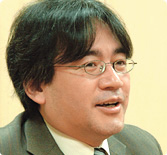
Well, on this subject, I've often said half-jokingly: "In this game, even the sides of the ladders have patterns on them!" (laughs) But whenever you climb a ladder, the camera moves so it's directly behind you meaning you can't actually see the sides of the ladder!
Miyamoto-san, are you implying that there was some bad management in the development team? (laughs)
How much time did you spend on that part? (laughs)
Well, let's forget that particular point for now! (laughs)
Agreed! (laughs)
It's a well-known fact that Zelda games always have signposts that can be sliced apart by the player. The village at the beginning of this game is no exception. However in this game, finally, the pieces you cut off can be picked up!
(roaring laughter)
And of course, if you throw them into the river they float.
(laughter)
They really do float. The reason we enabled the player to pick up the pieces and carry them was because there were no signposts right by the river.
Exactly! (laughs) If you don't take them and throw them into the river, they're not going to float.
And because we've made it so the pieces float, it'd be a real waste if the player didn't get to see this. That's why we let them pick them up, carry them to the river and throw them in! Setting up this feature took us about the same time as it did to work on one of the horses! (laughs)
A fine example of putting the cart before the horse! (laughs)
It really was! (laughs)
We often couldn't be sure which was the horse and which was the cart! (laughs)
There are plenty of these touches in this Zelda for the player to enjoy. And why did this happen, you might ask. Well, in the early stages of development neither the overall direction of the story, nor its finer details had been settled on. For that reason, the development team concentrated on creating things that could be used however the story turned out. The enemies were designed so that they could appear at any location throughout the game and the items were made so they could be used just about anywhere. Normally, when the framework for a game is decided you basically try to put all of the things you have made already into the game, making adjustments to them to ensure the minimum amount of waste. However, this time round with Zelda the trial-and-error process was so long that a large number of things made with great attention to detail remain in the game without having been through that adjustment process.
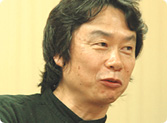
The perfect example are the characters who duck when you swing your sword at them! (laughs)
Ah yes! (laughs) There are some children who duck out of the way when you swing your sword at them!
(laughs)
In previous Zelda adventures, the non-player characters show little or no reaction if you swing at them. We had this feature left over from something made as an experiement quite some time ago, and for some reason we made it so only the children dodge Link's sword.
Well, speaking to those children isn't particularly interesting, but when you swing that sword they all duck! People say things like: "That's the funniest part!" (laughs) Actually, one of them dodges the strike by bending backwards.
The shortest one, right?
Well, seeing as this rather silly part of the game doesn't ruin the storyline, it'd be nice if we could show a video clip if at all possible…
There are many of these kinds of moments in the early stages of the game. We were making them right from the initial development stages.
What else was there… Ah yes, we already talked a little about the goat-throwing section, but to continue from that, there are a pre-determined number of goats that appear in the game. When I found out the reason for this, I was quite speechless! (laughs) The way it works is, there's an event where Link has to round up a certain number of goats. The number of goats isn't determined by the event's difficulty, but instead by the number that can fit into the pens in the barn!
(laughter)
The number of places in the barn was set and that dictated the total number of goats we could have…
I spoke to the director about why we couldn't have a larger number, but he told me that it wouldn't be possible because there were only twenty-four spaces in the barn! (laughs) Also, in early versions of the game, Link couldn't even enter the barn.
So, you couldn't even see the number of pens?
Precisely! (laughs) What were you thinking, limiting the number of pens! But in the end, Link became able to enter the barn.
And from time to time when the goats escape, you can now go into the barn and check to see how many of the pens are empty. That's the kind of detail the team spent their time implementing! (laughs)
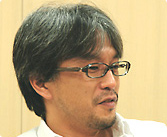
Nobody's going to check anyway! (laughs) There were many points like this throughout the game.
That's true. Before we knew it, all these details were already in the game!
Really? (laughs) So many nice touches have been put in the game, I think the most fun thing will be laughing out loud as you find them one by one. Since you're paying for the game anyway, you may as well get the most out of the experience!
Of course! (laughs)
For those who play the game, try moving the camera around from time to time and you'll find all kinds of wonderful things hidden away outside the main gameplay area if you take the time to look. (laughs)
We couldn't claim this to be a major selling point for the game though! (laughs)
There is a wealth of detail in the graphics so that when you pull the camera away it looks really impressive. This is in spite of the fact that you can't see these things when just playing through the game normally! (laughs) By changing the camera view occasionally, you'll suddenly catch a glimpse of some truly wonderful views.
That's absolutely right. Taking the time to have a look around can really pay off. There really are points that will make you think: "This is a breathtaking world." But that doesn't necessarily make the game good... (laughs)
I think it's a good thing. Even the enemy characters are wearing great-looking armour and equipment decorated with finely detailed textures. We The developers made it this way without considering how much you'd be able to see it when playing the game! (laughs) But we they did think that you'd be able to get a better look once the enemies had been knocked down.
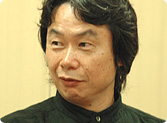
In this sense, we haven't made any compromises in bringing this world to life, and it's clear to see that the staff haven't cut any corners either.
It certainly gives that impression.
I once had a discussion with Hayao Miyazaki1 when he was making Porco Rosso2 and he asked me if I knew the way to make a landscape look authentic from a bird's-eye view. I wasn't sure and when I asked him what it was, he said: "Just keep drawing!" (laughs) It seems it's all about putting your nose to the grindstone and adding more and more detail. With this Zelda there were times when that was just what we did, and it was precisely because we put so much into the graphic detail that the game looks really good when the camera pulls away to take in the surrounding view. 1Hayao Miyazaki is the most celebrated animation director in Japan and has made films such as Princess Mononoke and Spirited Away. 2Porco Rosso refers to one of his films, released in Japan in 1992 about a cursed World War I fighter pilot who has the head of a pig.
Yes, I'd have to agree with you.
Those aspects might not always be seen when playing the game, but nonetheless I'd like to praise the staff on all the work they put into making those fine details! (laughs)
Everything you see in the game world is fully-formed, not made in the same way as the set of a TV programme which, if you view it from a certain angle, hasn't been fully built. Realising a vision like this may have been hugely expensive but you've really come up with a world you rarely see in video games. A lot of time and effort has gone into crafting all the details in this game, so I'd really like the players to thoroughly enjoy this rich gaming experience.
Even things such as the doors have been lovingly put together.
It's just another indication of the quality that's found in Zelda games. If we were making a game that only used a fixed camera angle for example, there would be no need to make things that appear on the sides or behind the player as they wouldn't be seen. But that's not the kind of approach we like to use for a Zelda game. We were also keen to make certain locations on the landscape interconnect and make them accessible from any direction., That's why we really feel that no corners have been cut. The reason we made such an effort to include as many features as possible is because our aim is to make people feel that the vast land of Hyrule is a true living and breathing environment.
Okay, finally I'd like to ask you both to give a message to the many fans who've been waiting for Zelda: Twilight Princess. Aonuma-san, would you like to start?
Well, to put it simply, I just want the fans to really embrace the wonderful world we've created. We worked ourselves to the bone making this and feel we've accomplished our goal and produced a truly great piece of work. I really hope you take the time to play this game as a new type of Zelda experience awaits you.
Miyamoto-san, what would you like to say?
I doubt there are many teams out there that could make something of this calibre. It's completely faithful to the spirit of Zelda, I mean, this game sticks to that clear path that a Zelda game must stick to. I know I can't predict how the world will react to this game, but I think I can safely say that there's nothing else like this available. The staff remained positive, and even when they were exhausted they worked hard right until the last moment putting everything together. Because this game contains so much energy, I'd really like people to pick it up and give it a try. As for my role this time, I feel I've helped more in putting everything together into its final form, rather than assisting with the creative side. Now it's finished, I can look back and feel that it's been a very enjoyable experience. What do you think, Iwata-san?
Firstly, I think the final product really benefitted from the decision to extend the development time by an extra year. The sheer scale of this project meant that there wasn't a clear plan from the start, but in spite of this I feel that the Zelda development team achieved their true potential and demonstrated their astonishing ability by bringing all the elements of this game neatly together in one well-rounded package. I haven't had the chance to play the game through in its entirety yet, but I have been able to check all the individual pieces and can confidently say that the wealth of ideas and energy that has been put into this game really shines through. Even with all the resources we have here at Nintendo, we could only make something like this once every few years. In fact, it might not be easy to do something like this again, so I really want everyone to have a wonderful time playing this game.
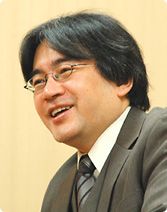
Indeed, and with this version of Zelda, you should really get your money's worth with over a hundred hours of gameplay.
And none of that time feels in the slightest like a chore, which is really an achievement.
When we say it will take a hundred hours, we don't mean you will spend half the time just building up your strength and supplies... Well, perhaps there is the odd time you have to collect rupees, but that's it! (laughs) Even then, we have made it so that the player will have fun coming up with ideas to get those rupees. This is a game you won't tire of!
Another thing is that this project has seen a mixture of creators, both old-timers and newcomers alike who've worked together to produce ideas that manage to combine a fresh approach with oddly nostalgic gameplay.
And because of that, I think we've made a game that has a very broad appeal.
That's right, and even people of Miyamoto-san's generation will be playing this one! (laughs) Three generations of people will be able to enjoy this gaming experience.
By "three generations", you mean like Touch Generations, right? (laughs)
Right. Which is a good thing! (laughs)
I also wanted to mention the sound and programming teams as well as the people who made the videos and demos. They didn't take part in these interviews, but worked just as hard as the rest.
That's right.
To tell the truth, I still have lots of questions I wanted to ask the developers in these interviews…
Speaking of which, these discussions are being translated and put on the international Nintendo sites as well, aren't they? I just wanted to add to the many fans of Zelda around the world that members of the foreign localisation teams came over and worked with us for a while during the development. And to these teams, I wanted to say that they really are very dedicated to what they do.
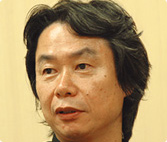
They certainly did work hard. This is actually the first time a Zelda game is being released simultaneously worldwide too. Various localisation teams from around the world came to Japan and worked together with us on making this possible.
They even worked alongside us until late at night.
They did. Generally speaking, I heard that most people in other countries tend not to work that late, but these guys sometimes worked until 1am!
I said to one of the European team members: "You're working late!" and they replied: "Yes, because the Japanese staff haven't gone home yet!"
(laughs)
There was a good sense of unity among us. When they went to the local convenience store to buy a late-night bento box to eat, we thought: "That's just what we do!" (laughs)
To the localisation teams that worked together on this project, you certainly know your Japanese culture!
I agree.
Another thing, there are more people translating the game's text into English than there were making the original Japanese! (laughs)
There were, weren't there? (laughs) There were people to pick out the intricacies of the original Japanese, others to convert the language into English and then even more people in charge of perfecting it and making it sound natural!
Not forgetting the people who iron out the parts of the story they think are weird! (laughs)
(laughter)
I'd just like to say thank you to everyone for spending such a long time today answering my questions.
Thank you.
Thank you very much.
(And that ends the Zelda: Twilight Princess interviews. The next series will focus on WarioWare: Smooth Moves)
